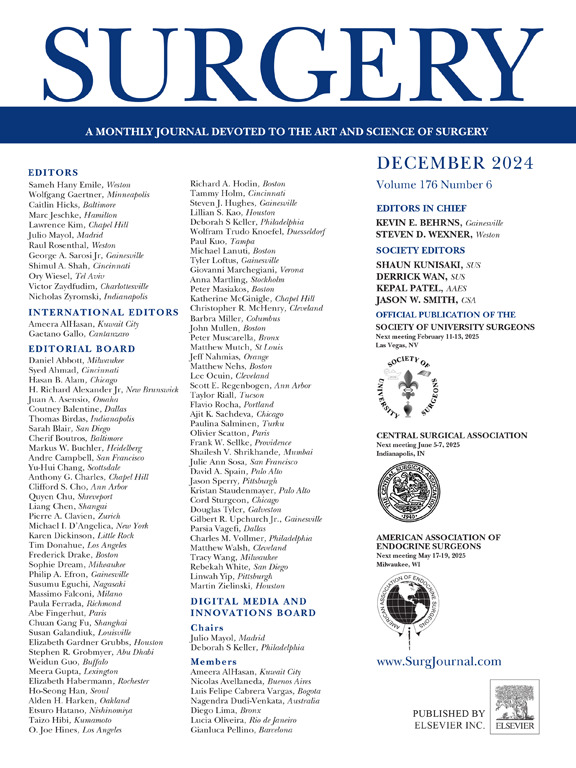Isolated surgical valve replacement for tricuspid regurgitation: An international multicenter study
IF 3.2
2区 医学
Q1 SURGERY
引用次数: 0
Abstract
Background
Although the management of tricuspid regurgitation during mitral surgery is standardized, the approach to patients with isolated tricuspid regurgitation is less clearly defined. This study examined the surgical outcomes of patients who underwent isolated surgical tricuspid valve replacement at 2 medical centers, providing insights into the postoperative and midterm outcomes.
Methods
This retrospective observational study analyzed data from 2 tertiary cardiac surgery centers. All patients underwent isolated surgical tricuspid valve replacement between 2010 and 2023. The primary end point included 30-day and midterm survival. The secondary end points included postoperative and valve-related complications.
Results
A total of 64 patients were included. The mean age was 58 ± 17 years, and 51.6% (33/64) were male patients. The median European System for Cardiac Operative Risk Evaluation II, TRISCORE, and Model for End-Stage Liver Disease scores were 2.16 [1.38–3.42], 3.00 [1.00–4.00], and 10.50 [9.00–16.25], respectively. More than 60% of the procedures were conducted on a beating heart. Thirty-day mortality was 7.8%. European System for Cardiac Operative Risk Evaluation II underestimated mortality, whereas the Model for End-Stage Liver Disease score was a more reliable predictor. Ten patients finally received a permanent pacemaker upon discharge. The overall survival rates at 1 and 6 years were 88.8 ± 4.0% and 80.3 ± 7.3%, respectively. Freedom from tricuspid valve reintervention rates at 1 and 6 years were 96.2 ± 2.6% and 75.0 ± 9.6%, respectively.
Conclusion
This study demonstrated that isolated surgical tricuspid valve replacement can be undertaken without exposing patients to an excessively high mortality risk. Risk assessment using specific scores may be useful in this regard. Nevertheless, these patients are at risk of postoperative complications, particularly permanent pacemaker implantation.

孤立外科瓣膜置换术治疗三尖瓣反流:一项国际多中心研究
背景:虽然二尖瓣手术中三尖瓣反流的处理是标准化的,但孤立性三尖瓣反流患者的治疗方法却不太明确。本研究调查了在2个医疗中心接受孤立手术三尖瓣置换术的患者的手术结果,提供了对术后和中期结果的见解。方法回顾性观察分析2个三级心脏外科中心的资料。所有患者均在2010年至2023年间接受了分离性三尖瓣置换术。主要终点包括30天和中期生存期。次要终点包括术后和瓣膜相关并发症。结果共纳入64例患者。平均年龄58±17岁,男性占51.6%(33/64)。欧洲心脏手术风险评估系统II、TRISCORE和终末期肝病模型评分的中位数分别为2.16[1.38-3.42]、3.00[1.00-4.00]和10.50[9.00-16.25]。超过60%的手术是在一颗跳动的心脏上进行的。30天死亡率为7.8%。欧洲心脏手术风险评估系统II低估了死亡率,而终末期肝病评分模型是一个更可靠的预测因子。10名患者最终在出院时接受了永久性起搏器。1年和6年总生存率分别为88.8±4.0%和80.3±7.3%。1年和6年三尖瓣再干预率分别为96.2±2.6%和75.0±9.6%。结论:本研究表明,孤立的三尖瓣置换术可以在不使患者面临过高死亡风险的情况下进行。在这方面,使用特定分数进行风险评估可能是有用的。然而,这些患者有术后并发症的风险,特别是永久性起搏器植入。
本文章由计算机程序翻译,如有差异,请以英文原文为准。
求助全文
约1分钟内获得全文
求助全文
来源期刊

Surgery
医学-外科
CiteScore
5.40
自引率
5.30%
发文量
687
审稿时长
64 days
期刊介绍:
For 66 years, Surgery has published practical, authoritative information about procedures, clinical advances, and major trends shaping general surgery. Each issue features original scientific contributions and clinical reports. Peer-reviewed articles cover topics in oncology, trauma, gastrointestinal, vascular, and transplantation surgery. The journal also publishes papers from the meetings of its sponsoring societies, the Society of University Surgeons, the Central Surgical Association, and the American Association of Endocrine Surgeons.
 求助内容:
求助内容: 应助结果提醒方式:
应助结果提醒方式:


